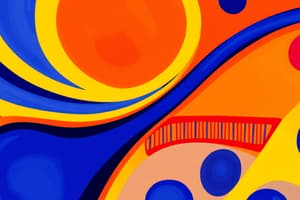Podcast
Questions and Answers
What is the main component of a cell membrane?
What is the main component of a cell membrane?
- Carbohydrate
- Lipid bilayer (correct)
- Nucleic acid
- Protein
What is the function of the hydrophilic heads in a lipid bilayer?
What is the function of the hydrophilic heads in a lipid bilayer?
- To provide structural support
- To interact with water (correct)
- To block the movement of particles
- To facilitate active transport
What is the purpose of facilitated diffusion in a cell?
What is the purpose of facilitated diffusion in a cell?
- To synthesize proteins
- To regulate the cell's pH
- To move particles down their concentration gradient (correct)
- To move particles against their concentration gradient
What is the name of the protein that facilitates the movement of chloride ions across the cell membrane?
What is the name of the protein that facilitates the movement of chloride ions across the cell membrane?
What is the shape of the pocket in the chloride channel?
What is the shape of the pocket in the chloride channel?
What is the location of the chloride ion in the example given in the video?
What is the location of the chloride ion in the example given in the video?
What is the term for the movement of particles from an area of high concentration to an area of low concentration?
What is the term for the movement of particles from an area of high concentration to an area of low concentration?
What is the name of the type of transport that involves the use of energy to move particles across the cell membrane?
What is the name of the type of transport that involves the use of energy to move particles across the cell membrane?
What is the primary function of the pocket in the protein?
What is the primary function of the pocket in the protein?
What happens to the chloride ion when the protein changes its conformation?
What happens to the chloride ion when the protein changes its conformation?
What is the driving force behind the protein's conformational changes?
What is the driving force behind the protein's conformational changes?
What is the ultimate outcome of the protein's conformational changes?
What is the ultimate outcome of the protein's conformational changes?
What is the role of ATP in the chloride ion transport process?
What is the role of ATP in the chloride ion transport process?
What is the purpose of the protein's conformational changes?
What is the purpose of the protein's conformational changes?
What is the final state of the protein after the chloride ion has been transported into the cell?
What is the final state of the protein after the chloride ion has been transported into the cell?
What is the relationship between the protein's conformation and the chloride ion?
What is the relationship between the protein's conformation and the chloride ion?
Flashcards are hidden until you start studying
Study Notes
Cell Membrane Structure
- A cell membrane is a lipid bilayer, consisting of hydrophilic heads and hydrophobic tails.
- Hydrophilic heads are situated on the outside and inside of the cell, while hydrophobic tails are in the middle.
- The hydrophobic tails are kinked, forming the hydrophobic core of the lipid bilayer.
Passive Transport
- Passive transport is a method of moving particles across a cell membrane without using energy.
- There are four types of passive transport, with Facilitated Diffusion being the main type focused on in this video.
Facilitated Diffusion
- Facilitated Diffusion is a type of passive transport that involves moving particles across a cell membrane with the help of proteins.
- Proteins are embedded in the cell membrane and facilitate the movement of particles.
- In this example, a chloride channel protein is used to facilitate the movement of chloride ions into the cell.
Chloride Channel Protein
- The chloride channel protein has a specific pocket that is shaped to fit chloride ions.
- When a chloride ion binds to the protein, it makes the protein uncomfortable, causing it to change its conformation.
- The protein changes its shape, allowing the chloride ion to move into the cell.
- Once the chloride ion is released, the protein returns to its original shape, ready to facilitate the movement of another chloride ion.
Conformation Change
- The protein changes its conformation to become more comfortable, whether it's binding to a chloride ion or not.
- The conformation change allows the protein to facilitate the movement of chloride ions into the cell without using energy.
Studying That Suits You
Use AI to generate personalized quizzes and flashcards to suit your learning preferences.



